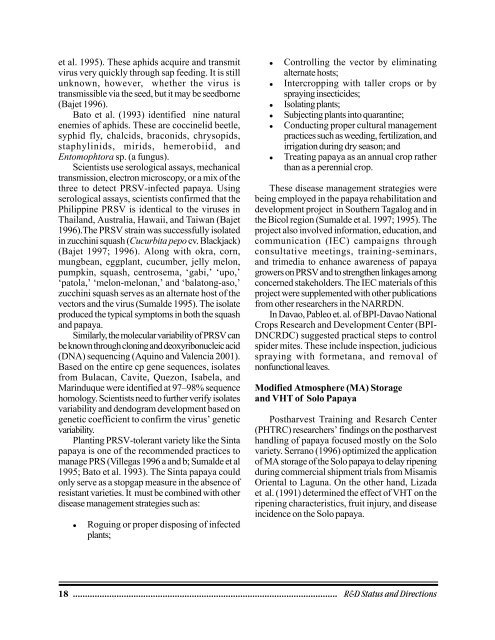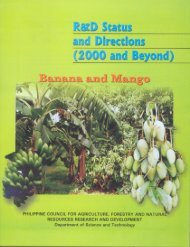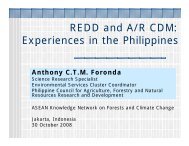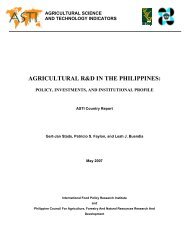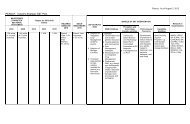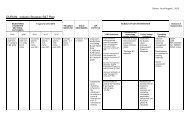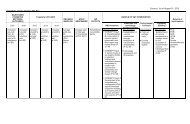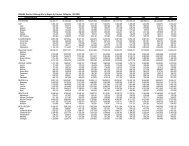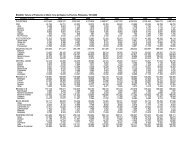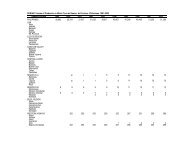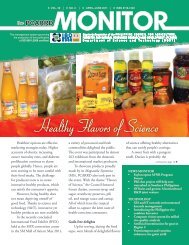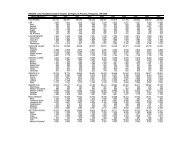Part I. R& D Status - pcaarrd - Department of Science and Technology
Part I. R& D Status - pcaarrd - Department of Science and Technology
Part I. R& D Status - pcaarrd - Department of Science and Technology
You also want an ePaper? Increase the reach of your titles
YUMPU automatically turns print PDFs into web optimized ePapers that Google loves.
et al. 1995). These aphids acquire <strong>and</strong> transmit<br />
virus very quickly through sap feeding. It is still<br />
unknown, however, whether the virus is<br />
transmissible via the seed, but it may be seedborne<br />
(Bajet 1996).<br />
Bato et al. (1993) identified nine natural<br />
enemies <strong>of</strong> aphids. These are coccinelid beetle,<br />
syphid fly, chalcids, braconids, chrysopids,<br />
staphylinids, mirids, hemerobiid, <strong>and</strong><br />
Entomophtora sp. (a fungus).<br />
Scientists use serological assays, mechanical<br />
transmission, electron microscopy, or a mix <strong>of</strong> the<br />
three to detect PRSV-infected papaya. Using<br />
serological assays, scientists confirmed that the<br />
Philippine PRSV is identical to the viruses in<br />
Thail<strong>and</strong>, Australia, Hawaii, <strong>and</strong> Taiwan (Bajet<br />
1996).The PRSV strain was successfully isolated<br />
in zucchini squash (Cucurbita pepo cv. Blackjack)<br />
(Bajet 1997; 1996). Along with okra, corn,<br />
mungbean, eggplant, cucumber, jelly melon,<br />
pumpkin, squash, centrosema, ‘gabi,’ ‘upo,’<br />
‘patola,’ ‘melon-melonan,’ <strong>and</strong> ‘balatong-aso,’<br />
zucchini squash serves as an alternate host <strong>of</strong> the<br />
vectors <strong>and</strong> the virus (Sumalde 1995). The isolate<br />
produced the typical symptoms in both the squash<br />
<strong>and</strong> papaya.<br />
Similarly, the molecular variability <strong>of</strong> PRSV can<br />
be known through cloning <strong>and</strong> deoxyribonucleic acid<br />
(DNA) sequencing (Aquino <strong>and</strong> Valencia 2001).<br />
Based on the entire cp gene sequences, isolates<br />
from Bulacan, Cavite, Quezon, Isabela, <strong>and</strong><br />
Marinduque were identified at 97–98% sequence<br />
homology. Scientists need to further verify isolates<br />
variability <strong>and</strong> dendogram development based on<br />
genetic coefficient to confirm the virus’ genetic<br />
variability.<br />
Planting PRSV-tolerant variety like the Sinta<br />
papaya is one <strong>of</strong> the recommended practices to<br />
manage PRS (Villegas 1996 a <strong>and</strong> b; Sumalde et al<br />
1995; Bato et al. 1993). The Sinta papaya could<br />
only serve as a stopgap measure in the absence <strong>of</strong><br />
resistant varieties. It must be combined with other<br />
disease management strategies such as:<br />
• Roguing or proper disposing <strong>of</strong> infected<br />
plants;<br />
• Controlling the vector by eliminating<br />
alternate hosts;<br />
• Intercropping with taller crops or by<br />
spraying insecticides;<br />
• Isolating plants;<br />
• Subjecting plants into quarantine;<br />
• Conducting proper cultural management<br />
practices such as weeding, fertilization, <strong>and</strong><br />
irrigation during dry season; <strong>and</strong><br />
• Treating papaya as an annual crop rather<br />
than as a perennial crop.<br />
These disease management strategies were<br />
being employed in the papaya rehabilitation <strong>and</strong><br />
development project in Southern Tagalog <strong>and</strong> in<br />
the Bicol region (Sumalde et al. 1997; 1995). The<br />
project also involved information, education, <strong>and</strong><br />
communication (IEC) campaigns through<br />
consultative meetings, training-seminars,<br />
<strong>and</strong> trimedia to enhance awareness <strong>of</strong> papaya<br />
growers on PRSV <strong>and</strong> to strengthen linkages among<br />
concerned stakeholders. The IEC materials <strong>of</strong> this<br />
project were supplemented with other publications<br />
from other researchers in the NARRDN.<br />
In Davao, Pableo et. al. <strong>of</strong> BPI-Davao National<br />
Crops Research <strong>and</strong> Development Center (BPI-<br />
DNCRDC) suggested practical steps to control<br />
spider mites. These include inspection, judicious<br />
spraying with formetana, <strong>and</strong> removal <strong>of</strong><br />
nonfunctional leaves.<br />
Modified Atmosphere (MA) Storage<br />
<strong>and</strong> VHT <strong>of</strong> Solo Papaya<br />
Postharvest Training <strong>and</strong> Resarch Center<br />
(PHTRC) researchers’ findings on the postharvest<br />
h<strong>and</strong>ling <strong>of</strong> papaya focused mostly on the Solo<br />
variety. Serrano (1996) optimized the application<br />
<strong>of</strong> MA storage <strong>of</strong> the Solo papaya to delay ripening<br />
during commercial shipment trials from Misamis<br />
Oriental to Laguna. On the other h<strong>and</strong>, Lizada<br />
et al. (1991) determined the effect <strong>of</strong> VHT on the<br />
ripening characteristics, fruit injury, <strong>and</strong> disease<br />
incidence on the Solo papaya.<br />
18 ............................................................................................................. R&D <strong>Status</strong> <strong>and</strong> Directions


